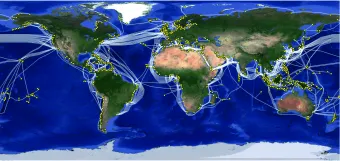
- Seafloor cables carry over 95% of all digital data traffic worldwide, crucial to our everyday lives.
- A new global study led by the National Oceanography Centre (NOC) has revealed how climate change may increase the threats posed by natural hazards to these networks.
- The research provides vital evidence to enable the design of resilient future cables and their routes.
A new global study led by the National Oceanography Centre (NOC) has addressed how climate change may increase the threats posed by natural hazards.
The hazards include coastal flooding and sea level rise, to a network of over 1.3 million km of underwater fibre-optic cables that keep the Internet running.
Seafloor cables carry over 95% of all digital data traffic worldwide, including financial trading information and social media communications. This vast undersea network is designed to be as resilient as possible to natural hazards such as storms, earthquakes, and sea level rise. In a new study, scientists at NOC provide the first global view on where and how these hazards will change to ensure the underwater cable industry continues to maintain a resilient global network.
The impacts of climate change are increasingly being felt on land, from flooding of coastal communities, landslides that destroy houses and roads, to heat waves that cripple rail networks. However, little attention has been paid to the impacts that will be felt by the vast network of seafloor cables that span the world’s oceans. Threats such as storms and sea level rise are changing radically as a result of climate change, in many cases increasing in intensity and affecting completely new regions.
Lead author, Dr Mike Clare at NOC, said: “Subsea cables are crucial to our daily lives, enabling remote working, education, financial trading, and access to telemedicine. As we are increasingly reliant on this global network, it is essential that we assess any potential future disruptions that may emerge as a result of climate change.”
“Our reliance on cables that are no wider than a garden hose is a surprise to many, who regard satellites as the main means of communication. But satellites simply don’t have the bandwidth to support modern digital systems. The ‘Cloud’ is not in the sky – it is under the sea. This study and ongoing research will help mitigate any social and economic impacts that could arise if industry is not well-informed and prepared.”
Natural hazards such as earthquakes, tropical cyclones and underwater volcanoes account for less than 20% of cable damage that occurs each year. When such events do occur, they can affect very large areas of the seafloor, damaging multiple cables to disrupt communications.
Dr Isobel Yeo, marine volcanologist at NOC said: “Underwater cables can be vulnerable to damage, resulting in costly repairs. Delays to those repairs can lead to significant knock-on costs. As shown by the case of the 2022 Hunga volcano offshore Tonga, this can result in whole nations being temporarily cut off from global digital communications.”
The study identified regional climate change ‘hotspots’ where threats to subsea cables may become more intense. These include areas off Taiwan where changes to tropical cyclone intensity and frequency have already increased cable damage, and in polar latitudes where melting glacial and sea ice are profoundly changing ocean conditions more rapidly than many other places on Earth.
This new scientific research provides much-needed evidence to enable the design of resilient future cables and their routes.
Read the full open access paper in Earth Science Reviews
The project was an international collaboration with the University of Southampton, U.S. Geological Survey (USA), University of Central Florida (USA), Victoria University of Wellington (New Zealand) and the International Cable Protection Committee and was funded by the Natural Environment Research Council under the COP26 Adaptation and Resilience Scoping Call.